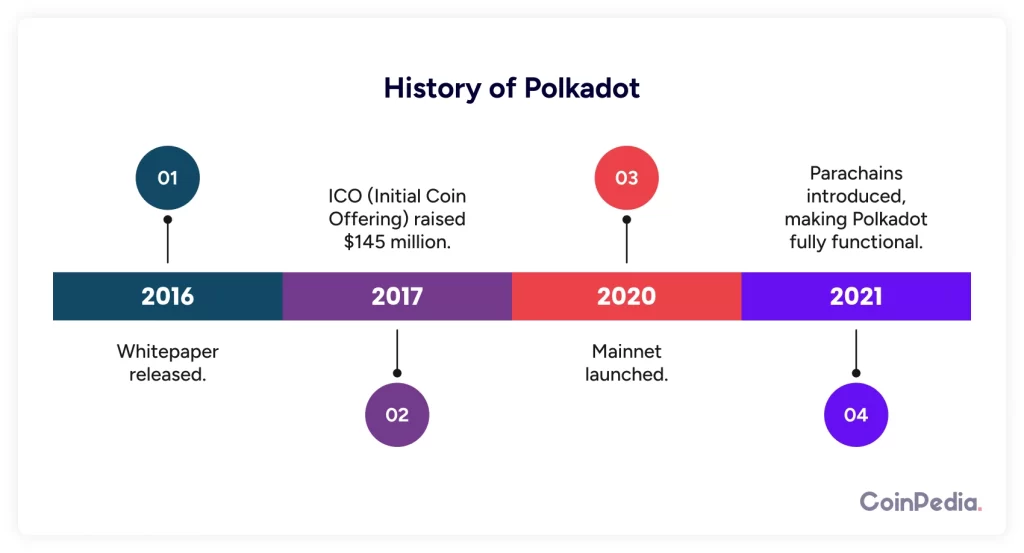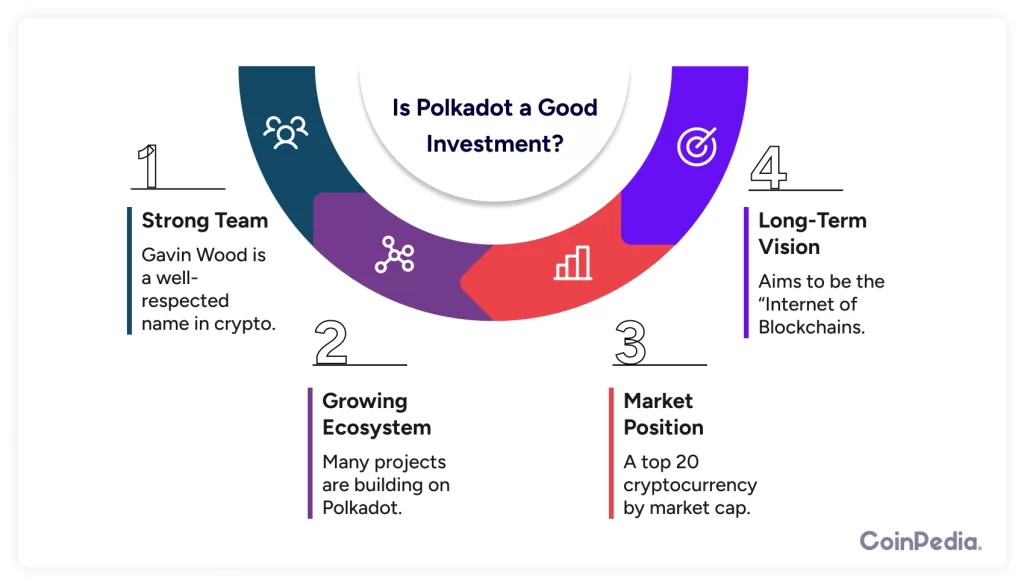
Imagine if Bitcoin and Ethereum could seamlessly share information. What if different blockchains could work together without relying on centralized exchanges? This is exactly what Polkadot is trying to solve.
In the fast-moving world of crypto, where hundreds of blockchains exist, Polkadot aims to connect them all. It’s like a universal translator for blockchains, making them work together efficiently. But is it really the future, or just another overhyped project? Let’s dive in.
What is Polkadot?
Polkadot is a multi-chain network that allows different blockchains to connect and communicate. Unlike Bitcoin and Ethereum, which operate independently, Polkadot creates an ecosystem where multiple blockchains can interact.
Think of it as a giant internet for blockchains. Instead of every blockchain working in isolation, Polkadot brings them together under one roof. This is done through a unique architecture involving a main chain (Relay Chain) and multiple connected chains (Parachains).
Here’s what makes Polkadot special:
- Interoperability: It connects different blockchains.
- Scalability: It processes transactions across multiple chains at once.
- Customization: Developers can create their own specialized blockchains.
- Governance: It allows token holders to have a say in upgrades and decisions.
History of Polkadot
Polkadot was founded by Dr. Gavin Wood, one of the co-founders of Ethereum. If you’ve heard of Solidity, the programming language behind Ethereum smart contracts, you should know that Gavin Wood created it.
After working on Ethereum, he realized its limitations—especially in scalability and governance. So, in 2016, he left Ethereum and founded Polkadot. His vision? A blockchain network that could evolve and adapt without hard forks.
Polkadot’s journey so far:
- 2016: Whitepaper released.
- 2017: ICO (Initial Coin Offering) raised $145 million.
- 2020: Mainnet launched.
- 2021: Parachains introduced, making Polkadot fully functional.
Today, Polkadot is one of the top blockchain projects, with a strong developer community and growing adoption.

How Does Polkadot Work?
Polkadot isn’t just another blockchain. It has a unique way of working, which makes it different from Ethereum, Solana, or Bitcoin.
1. Relay Chain – The Heart of Polkadot
The Relay Chain is like the main highway where all the blockchains (parachains) connect. It processes transactions and ensures security across the network.
2. Parachains – Independent Blockchains
Parachains are smaller blockchains that connect to the Relay Chain. Each one can have its own rules, tokens, and governance. This makes Polkadot highly flexible.
Example: One parachain could be optimized for payments, while another focuses on NFTs.
3. Bridges – Connecting External Blockchains
Polkadot also has bridges that connect it to blockchains like Ethereum and Bitcoin. This allows for cross-chain transactions and communication.
In simple terms, Polkadot is a network of networks, making it easier for different blockchains to work together.
Advantages and Disadvantages of Polkadot
Every crypto project has pros and cons. Let’s break down Polkadot’s strengths and weaknesses.
Advantages
- Interoperability: Blockchains can share information without third parties.
- Scalability: Handles multiple transactions across different chains.
- Security: Uses shared security, making it harder to attack.
- Upgradeability: Can upgrade without hard forks.
- Developer-Friendly: Offers a framework for creating blockchains.
Disadvantages
- Parachain Slot Auctions: Getting a parachain slot is expensive and competitive.
- Complexity: Not as easy to understand as Bitcoin or Ethereum.
- Adoption Hurdles: Still growing, and not as widely used as Ethereum.
While Polkadot has impressive features, it still needs widespread adoption to compete with Ethereum or Solana.
Is Polkadot a Good Investment?
Investing in Polkadot ($DOT) depends on your belief in the project. Here are some things to consider:
- Strong Team: Gavin Wood is a well-respected name in crypto.
- Growing Ecosystem: Many projects are building on Polkadot.
- Market Position: A top 20 cryptocurrency by market cap.
- Long-Term Vision: Aims to be the “Internet of Blockchains.
However, risks exist: Crypto is volatile. Competes with Ethereum, Cosmos, and Avalanche. Relies on parachain adoption.
If you believe in the future of multi-chain interoperability, Polkadot could be a strong long-term play.

Future of Polkadot
Polkadot’s future looks promising, but it also faces challenges. Here’s what could shape its journey:
- More Parachains: As more projects launch, the network will grow stronger.
- Bridges to Other Blockchains: Improved cross-chain functionality could boost adoption.
- Institutional Interest: Big players entering could bring more value.
- Ethereum’s Competition: Ethereum 2.0 and Layer-2 solutions might impact Polkadot.
If Polkadot can overcome these challenges, it could become a major player in crypto for years to come.
Final Thoughts
Polkadot is an ambitious project aiming to connect blockchains in a seamless way. It has a strong team, unique technology, and a vision for the future.
However, adoption is key. If more projects and users join, Polkadot could be a game-changer. But if it fails to attract developers, it may struggle to compete with Ethereum and other platforms.
So, is Polkadot worth watching? Absolutely. Is it a guaranteed success? That’s still up for debate.
FAQs
Polkadot is a multi-chain network that connects blockchains via a main Relay Chain, allowing seamless interoperability and scalability.
Polkadot offers better scalability and interoperability, but Ethereum has wider adoption and a larger ecosystem of dApps and developers.
Polkadot has strong tech and leadership, but success depends on adoption. It’s a long-term bet on blockchain interoperability.
Well Done! You have now completed the Lesson.
Complete the Quiz and Get Certified! All The Best!
We'd Love to Hear Your Thoughts on This Article!
Was this writing helpful?
 Yes
Yes  No
No
Disclaimer and Risk Warning
The information provided in this content by Coinpedia Academy is for general knowledge and educational purpose only. It is not financial, professional or legal advice, and does not endorse any specific product or service. The organization is not responsible for any losses you may experience. And, Creators own the copyright for images and videos used. If you find any of the contents published inappropriate, please feel free to inform us.



